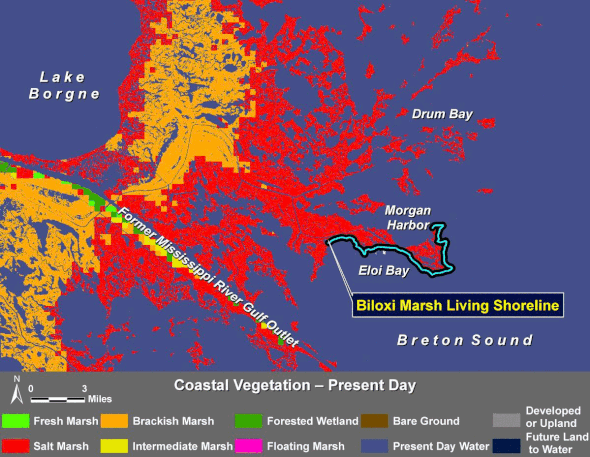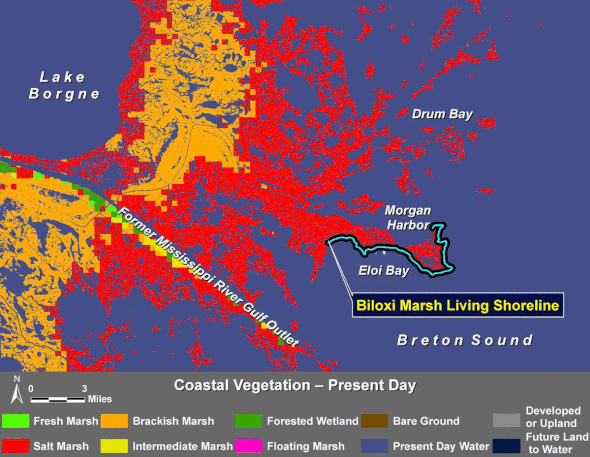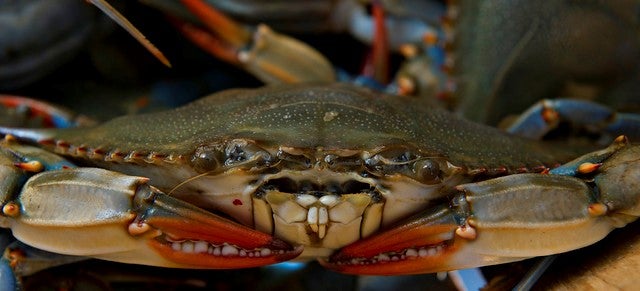This Living Shoreline Project Gives New Life to Marsh and Fisheries
To restore Louisiana’s coast, we need a suite of large-scale restoration projects across the coast working together to deliver maximum benefits to reduce land loss, restore ecosystems and maintain healthy and diverse habitat. In our “Restoration Project Highlights” series, we take a deeper look at specific projects from our list of Priority Projects, highlighting why they’re needed and hearing local perspectives on their importance.
*This blog was updated on 05/13/2022 to reflect current project status
The Biloxi Marsh is in St. Bernard Parish in Eloi Bay, which is in the Breton-Chandeleur basin. This marsh provides an important line of protection for New Orleans and neighboring communities. However, marsh has been lost in this area for years due to wave-induced shoreline erosion. Louisiana’s 2017 Coastal Master Plan projects that during a 100-year flood event almost all of Biloxi Marsh would experience flood depths of more than 15 feet. The closure of the Mississippi River Gulf Outlet (MRGO) helped control salinity intrusion in the area, and widespread restoration is now taking place, including building oyster reefs, shoreline protection and marsh creation projects.
What is the Biloxi Marsh Living Shoreline project?

The Biloxi Marsh Living Shoreline project will create living oyster reefs and shoreline protection along a shoreline of Eloi Bay, near the mouth of Bayou la Loutre. The project will use hardened materials (which could include concrete, steel, rock or oyster shell) to create a breakwater that will provide protection against wave erosion and provide hard substrate where oysters can settle and grow. When complete, this project will provide 9 to 11 miles of shoreline protection for degrading marsh.
This project is directly adjacent to a previously completed Coastal Protection and Restoration Authority (CPRA) Living Shoreline Demonstration project that constructed 3.2 miles of shoreline. It is also near a Coalition to Restore Coastal Louisiana recycled oyster reef project that constructed half a mile of reef, as well as two Nature Conservancy reefs. In their 2018 Coastal Strategy Document, the St. Bernard Parish government proposed constructing living shoreline along the entirety of the Biloxi Marsh perimeter.
A local’s take on the Biloxi Marsh Living Shoreline project
Why is this project important?
Oyster reefs provide a wide suite of benefits besides being suitable for harvest. Oysters filter water, improving water quality; they provide habitat for fish and invertebrates; and they can help protect shorelines from erosion. This project is directly adjacent to the state’s public oyster seed grounds, so any oyster recruitment will also benefit oysters there. This project is expected to prevent the loss of 120-146 acres of land over its 20-year lifetime.
When will this project be constructed?
The Biloxi Marsh Living Shoreline project is currently in construction. The total estimated cost is $57.7 million.
What does a future without action look like?
What does a future without action look like?
|
What does a future with action look like?
|
 |
 |
How will this project benefit wildlife?

Photo of Callinectes sapidus, or the Blue Crab up close. Credit: Benjamin Wilson.
Many coastal species spend part of their lives on oyster reefs. This is because oyster reefs provide protection during fragile stages of early development. One species that you can frequently find on oyster reefs in Louisiana is the Atlantic blue crab. This species of crab is the most commonly caught commercial species of crab in Louisiana. They are also a top predator of oysters, which is why they enjoy living on oyster reefs. Other species you can find on oyster reefs are shrimp, flounder, menhaden, croaker and many other commercially important fish species.
Be a voice of support for this critical restoration project! Sign up here:
Sign up here to stay updated on this project and to hear about opportunities to advocate for its completion.